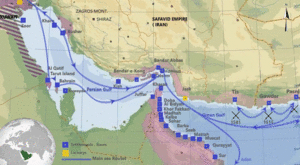Battle off Hormuz (1625) facts for kids
Quick facts for kids Battle off Hormuz (1625) |
|||||||
|---|---|---|---|---|---|---|---|
 Batalha Naval de Ormuz, by João Dantas, c. 1812. |
|||||||
|
|||||||
| Belligerents | |||||||
Supported by: |
|||||||
| Commanders and leaders | |||||||
| Strength | |||||||
| 8 galleons 20 light galleys 20 terranquins |
8 carracks 2 pataches |
||||||
| Casualties and losses | |||||||
| 130 killed | 29 English killed 45 Dutch killed |
||||||
The Battle off Hormuz was a big naval fight that happened on February 11–12, 1625. It took place in the Persian Gulf, which is a sea area between Iran and the Arabian Peninsula. Some people call it the Battle of the Persian Gulf.
This battle was between the Portuguese Empire and a combined fleet of two powerful trading companies: the Dutch East India Company (VOC) and the English East India Company (EIC). Even though the battle ended in a tie, it meant that Portugal started to lose its power in the Persian Gulf region.
Contents
A Fight for Control
Portugal's Hold on Hormuz
Portugal had taken control of Hormuz Island in 1507. Hormuz was an important trading spot. For a long time, it was like a smaller state under Portuguese rule.
But in 1622, the Persians, with help from the English, captured Hormuz. They took it from Portugal. After this, the Portuguese tried many times to get back the fortress of Hormuz.
The Siege and New Arrivals
A Portuguese commander named Rui Freire de Andrada was trying to take back Hormuz. He had a fleet of galleys, which are ships powered by oars. He was waiting for more ships and soldiers from Portugal.
But in early 1625, a combined fleet of English and Dutch ships arrived. They forced Andrada to stop his attack on Hormuz. This happened just a few weeks before the Portuguese reinforcements arrived.
Getting Ready for Battle
The Fleets Gather
The English and Dutch knew that more Portuguese ships were coming. These ships, led by Nuno Álvares Botelho, had arrived in Goa, India, in September 1624.
The allied English and Dutch fleet left Surat, India. They sailed to the Strait of Hormuz in January 1625. This arrival made Andrada stop his siege of Hormuz. Botelho's Portuguese fleet arrived on February 10.
Ships and Commanders
The Portuguese fleet had eight large sailing ships called galleons. These were led by Botelho. They also had about 20 smaller, oar-powered galleys under Andrada.
The English and Dutch fleet had eight big ships and two smaller ones. These ships were commanded by John Weddell for the English and Albert Becker for the Dutch.
The Battle Begins
A Huge Sea Fight
Botelho started the battle early on February 11. What followed was one of the biggest sea battles ever fought in Asian waters during that time.
A Portuguese person who saw the battle said the sound of the cannons firing was incredibly loud. It was like the "mouths of Hell" opening. The Persians watching from the shore were amazed.
The English commander, John Weddell, said that the Persian governor of Bandar Abbas and the English agent in town watched the battle from their rooftops. They counted between 16,000 and 17,000 cannon shots fired over two days.
After the Fighting
After two days of intense fighting, both fleets pulled back. Many ships were badly damaged, but none sank. All the ships were still floating.
Botelho decided not to retreat to the coast of Arabia. He wanted to wait and see if his enemies would attack Muscat, a Portuguese city.
The two fleets stayed anchored near each other for a while. The Portuguese were off Larak Island. The English and Dutch were near Bandar Abbas. Later that month, the English and Dutch decided to leave.
The Portuguese sailed out to fight them again, but this second fight didn't have a clear winner. Botelho then took his fleet to Muscat for repairs.
Casualties and Aftermath
Who Was Lost
Botelho reported that 130 of his Portuguese men were killed in the battle. The English reported 29 killed, and the Dutch reported 45 killed. The difference in numbers might be because of the different fighting methods used by each side.
A New Agreement
After the battle, Persia and Portugal signed a treaty. A treaty is like a formal agreement. This one was basically a truce, which is a stop to fighting. It helped set up how they would trade in the Persian Gulf.
Most people agree the treaty was signed in 1625, but the actual document doesn't have a date. It might have been signed as late as 1630.
The treaty allowed Portugal to choose a Persian port to set up a trading center. Portuguese ships had to trade there instead of at Arabian ports. Portugal would also get half of the money from customs taxes. The Portuguese chose Bandar Kong as their trading port. This treaty didn't involve either side giving up any land.


